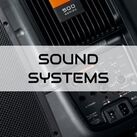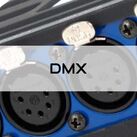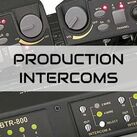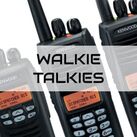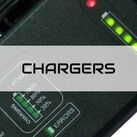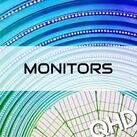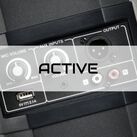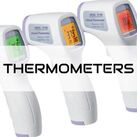021 201 7250 | sales@progearsa.co.za
The REMOTE AUDIO BDSV5 : BATTERY DISTRIBUTION SYSTEM and REMOTE AUDIO BDSV5H : BATTERY DISTRIBUTION SYSTEM are the next generation of the Remote Audio BDS, the standard in power management systems for ENG audio bags. It is a 12V nominal compact DC power distribution system that now features dual power inputs that allow for battery hot swapping as well as input priority and load sharing for higher current draw conditions. It incorporates System Management Bus (SMBus) communications and a built in 0.95” colour OLED display for detailed usage and runtime statistics when using smart batteries equipped with internal Battery Management Systems (BMS) such as Remote Audio’s HI-Q 49Wh and 98Wh batteries. Additionally, the BDSv5 SMART has been expanded from 6 to 8 outputs and is available with 2 output connector variants: Standard (5.5mm barrel jack) and Hirose (4-pin).
Key Features
Inputs: The BDSv5 SMART’s dual TA4-pin inputs can accept various types of batteries and DC input sources ranging from 9-18 Volts DC. The dual inputs feature an integrated power path controller meaning you no longer need to shut down critical gear when it comes time to change out a depleted battery pack. Simply remove one of the batteries from its corresponding battery cup and pop in a fresh one while the other battery will maintain an uninterrupted* output. The power path’s interconnected ideal diode controllers prevent reverse current flow from one battery into the other.
Priority Input: A new feature to the BDSv5 is input priority. When enabled in the settings menu, the BDS will prioritize drawing power from Input #1 while Input #2 goes into standby. This allows you to prioritize using say an AC to 12V DC adapted power supply plugged into Input #1 while conserving a 14.4V smart battery plugged into input #2. If the voltage of Input #1 falls below a threshold, the BDSv5 will automatically failover to the second input for uninterrupted power output. Once power is restored to Input #1, it resumes its priority role for powering the load and Input #2 will go back into standby. It should be noted that a battery in standby will still have a very small current draw on it from the battery communications and microprocessor of the BDSv5 so it is normal to see a battery in standby discharge slowly over time.
Load Sharing: Another new feature of the BDSv5 is a load sharing function between two batteries whereby you can power loads that draw more current than a single battery pack is capable of supplying by itself. For example, two HI-Q 49Wh, 3.4Ah batteries could supply up to 6.8Amps when load sharing, and two HI-Q 98Wh, 6.8Ah batteries could supply up to the BDS’s limit of 12 Amps total current when load sharing. To enable load sharing, you must turn off the Priority #1 setting in the settings menu. For best performance when load sharing, it is recommended to always use two batteries of equal capacity and similar states of charge. These features greatly expand the BDSv5’s useability from ENG bags of all sizes to small and even mid-sized cart systems.
Output Current Limit: Since the BDSv5 can accept multiple battery capacities and DC sources, the BDSv5 Smart employs a dynamic current limit and warning system. The maximum total load current handling of the BDSv5 is 12 Amps. However, depending on what the input source type is or whether you have just one input active, a lower current limitation and warning could be imposed. By default, any non-smart battery or DC input source is limited to 6 Amps (per TA-4 input). Smart batteries capable of BMS communications will be limited to a 1C maximum discharge rate for safety. 1C is a rate of 1 times the battery’s capacity so for a 49Wh battery with a capacity of 3.4 Amp hours, it would be limited to 3.4 Amps max current. Likewise, a 98Wh battery with a capacity of 6.8 Amp hours, would be limited to 6.8 Amps max current. Using two 49Wh smart batteries in load sharing would allow up to 6.8 Amps of current draw, while two 98Wh batteries would allow current draw up to the BDSv5’s overall maximum rating of 12 Amps. When the load current is over 80% of the allowed limit, the colour of the displayed load will change to yellow. When the load current is over 90% of the set limit, the colour of the displayed load will change to red. When an overload condition is sensed, the load portion of the display will show an “OVERLOAD!” alarm. If the overload is sustained the BDSv5 will trigger an automatic load shed, shutting down the switched outputs for ten seconds while the switch LED alternately flashes red and green. After the 10 seconds of shutdown, the BDSv5 will clear the alarm and try to reenable the switched outputs.
Display Modes: The BDSv5 SMART features a compact 0.95” colour OLED display to provide the user with enhanced smart battery telemetry. Double pressing the select button changes the display’s screen mode to allow the user to see additional Smart Battery data. The Default Screen mode displays the battery voltage in a large font and the battery’s state of charge and estimated runtime below it. In the second screen mode, battery voltage and the battery state of charge will swap locations and font sizes. The Load display will also change from displaying the total load in (A) Amps to (W) Watts. Double pressing the select button again changed to the third screen mode. The battery’s cycle count is displayed Inside the blue battery with the Temperature displayed in a large font next to it. Below is displayed the battery state of charge and the battery’s serial number. Double pressing the select button again will change the display back to the default screen.






